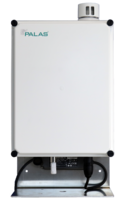Case Study | Environment
In the South Moravian Region of the Czech Republic, the burning of solid fuels in private households during the cold season is a significant source of air pollution. Despite general awareness of the negative effects, there has been a lack of concrete data to demonstrate the impact of local heating systems on air quality. This issue is particularly exacerbated by unfavorable meteorological conditions like inversions, which hinder the dispersion of pollutants.
Targeted Research for Clear Results
Our partner Envitech Bohemia launched a comprehensive project to investigate the impact of residential heating systems on air quality in three cities within the South Moravian Region. The project aimed to collect detailed data on aerosol particle concentrations of various sizes, with the goal of raising awareness about the issue and providing a foundation for air quality improvement measures. The project was largely funded by Norway Grants (Call SGS-2 “Svalbard”) and the State Environmental Fund.
A Hybrid Network for Comprehensive Monitoring
A key aspect of this project was the use of a hybrid network that combined different types of air quality monitoring systems to ensure both broad coverage and data accuracy (reference, near-reference and sensor-based devices).
This hybrid network included highly accurate reference and near-reference devices like the AQ Guard Smart 1000, which were used to calibrate and validate the data collected by the more cost-effective sensor-based systems. By integrating these various technologies, the project could monitor air quality across a wide area while maintaining the reliability of the data. This approach allowed the team to effectively assess the impact of local heating systems on air quality and ensured that the findings were scientifically robust.
Various devices of the type AQ Guard Smart 1000 from Palas GmbH were used in this project. These state-of-the-art stations were strategically placed in the cities of Znojmo, Vyškov, and Židlochovice. The devices measured not only particle concentrations but also meteorological data to analyze pollutant dispersion under different conditions. Additionally, sensor-based dust monitoring units were placed in areas with anticipated high heating usage, creating a comprehensive data set.
Overcoming Challenges on the Path to Clarity
During the campaign, several challenges arose, particularly concerning the accuracy of the sensor-based systems. While these systems are cost-effective, they exhibit biases and data quality issues under real-world conditions. To address these challenges, a 40-day comparative test was conducted prior to the main measurements, comparing the sensors with reference stations compliant with EN 16450. The resulting calibration and validation functions allowed for the adjustment of measurement data, leading to more accurate interpretation. AQ Guard Smart 1000 stations were used to monitor and correct potential measurement drifts in real-time, ensuring accuracy.
The data were displayed on an online portal allowing a clear comparison of the measured values in graphical and tabular form, to provide unlimited data access to all project participants in real time.
During the project, an exceptional event occurred when intense dust from the Sahara swept over the Czech Republic. This episode was detected by the reference instruments, but the more cost-effective sensor-based systems did not capture the phenomenon. This highlights the need for continuous review and calibration of the devices used, as well as the limitations of low-cost monitoring systems.
Insights That Call for Action
The results confirmed the significant impact of residential heating on air quality. A noticeable increase in PM10 and PM2.5 concentrations was observed, particularly in the late afternoon and evening, which is typical for areas with intense heating activity.
The topography of the cities also played a role; higher pollutant concentrations were recorded in densely built areas, such as near town halls, due to poorer ventilation and higher emissions from older buildings which are often still heated by solid fuel boilers no longer permitted in newer buildings. Also within the compared sites, there was a clearly visible difference between the concentrations of locations with different altitudes.
Another key finding was the correlation between outdoor temperature and particle concentration: the colder the temperature, the higher the measured values. Significant increases were noted on colder days in January, while concentrations were lower around December 21, 2023, due to milder weather conditions including rain and wind. Additionally, the study revealed that local sources are not the only contributors to air quality; long-range pollutant transport also plays a role, as evidenced by higher concentrations under certain wind conditions.
Education: Key to Long-Term Change
A significant aspect of the project was its educational component, which involved local schools. Seminars and educational initiatives were offered to students and teachers at local high schools, raising awareness about air quality and pollution. These efforts aimed to engage the younger generation in environmental and health issues, fostering a more sustainable approach to resource management.
Next Steps on the Path to Cleaner Air
The measured data confirmed the impact of local heating and combustion of solid fuels on air quality in the investigated region. Nationwide, it is predominant source of air pollution/emissions for the most problematic pollutants (Particulate Matter and Polycyclic Aromatic Hydrocarbons) in these days. The residential heating sources need to be in the center of focus with respect to an adoption of measures to improve air quality.
The project’s findings underscore the need for further research and the development of measures to reduce air pollution from residential heating systems. A follow-up project is planned to utilize the insights gained to promote targeted strategies for emission reduction. This will include investigating the impact of remote sources on air quality and assessing cross-border pollutant transport.
